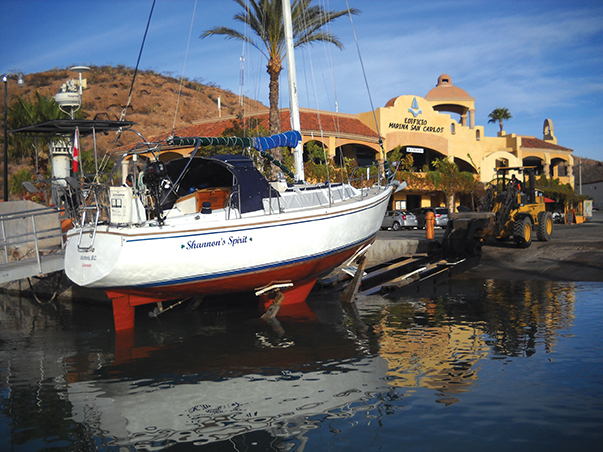
How to safely put your boat to bed in a Mexican boat yard (Published August 2016)
The first year we left our beloved 1986 Catalina 36, Mark I, Shannon’s Spirit, we asked a few cruisers who had been storing their boats in Mexico for many years. We took ALL their advice and were quite delighted when we returned to our boat, somewhat dustier, but no worse for wear, than when we’d left her.hen we sailed away from our dock in August 2011 we had no idea where our adventure would take us. We were prepared for anything and, ready to accept the call of the sea, we turned our bow south and set a course from Victoria, BC to Mexico. Once introduced to the Sea of Cortez, we realized we need go no further; we had found our cruising Mecca. We became ‘snow birds,’ sailing in the winter months and returning home to British Columbia for the summers. This meant we had to leave our boat in a potentially destructive climate and environment for as many as six or seven months at a time.
While preparing to leave our boat this season, we were approached by several people, newbies to the art of preparing their boat for storage. The question asked most often was “How much do we really need to do?” The quick answer is, “You can’t do too much”. However, given the intense heat, suffocating humidity and choking dust common during the Mexican ‘spring’, there is a balance between what you could do and what is reasonable given the working conditions. It’s not that hard, but it’s not for the faint of heart. Some would say it’s the price we pay for sailing in Paradise… and I guess they’re right. So, let’s get started. However, before I begin, let me just say that if you pose this question to every skipper you meet—you will get a different answer each time. This is ours…and it’s done us well for several years.
DO YOUR RESEARCH
The first thing to consider is what you’re trying to protect your boat from. You might think that theft or vandalism would be the first priority and, in some places it likely is. But today, in Mexico, most of us choose to leave our boats in dry storage yards that are being run as a business. Most are surrounded by fencing; most have one or more dogs prowling the premises; and most have at least one or two security guards. Admittedly, some yards are better than others. The good news is your research need go no further than the local cruising community. It doesn’t take long to suss out the reputations of each available yard, the good and the bad.
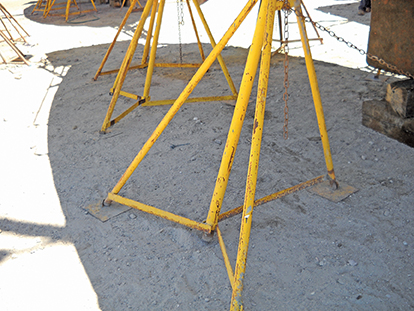
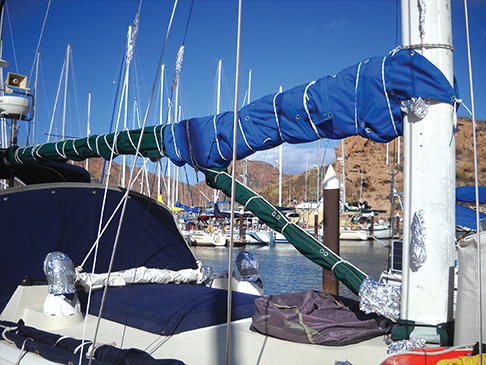
For instance, a yard that stores their boats on cement is preferable to one with only dirt. Stories abound about how quickly dirt can turn to soft quagmire in torrential rains. If your best choice of location still has a dirt yard, you can protect your boat somewhat by insisting on metal plates under each foot of each leg on each stand. If they don’t have plates, you should be able to find something suitable in a nearby hardware store or construction site. The number of stands is also important. A minimum of six to eight preferably, three down each side and one fore and aft, is our goal. Ensuring each support stand is located at a bulkhead is also a wise idea.
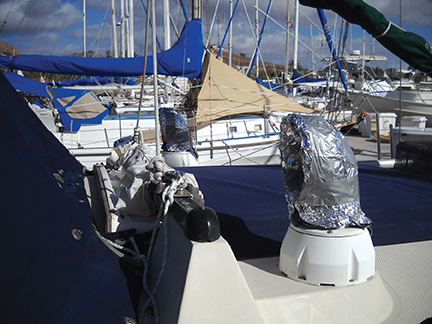
The consequences of Mother Nature’s wrath pretty much dictates the work we must do. Each year she insists on pelting our boats with torrential rain, sometimes using hurricane force winds. Even if you choose a location outside the official hurricane corridor, she will find you and she will toss winds at your boat that may not be officially named but are, nonetheless, fierce and forceful. If that isn’t ugly enough, she will also try to steam your boat open like a clam in a pot of boiling water. Extremely high temperatures, combined with dense humidity, can turn the inside of your boat into a healthy terrarium harboring molds and mildews for the duration. Sound like fun yet? Oh yes, I mustn’t forget to mention the critters; not just the crawling kind like ants, spiders and cockroaches; but also the flying ones. Small mud wasps, packing their nests into small holes and openings, are becoming more of a problem. Developing a personalized plan will go a long way to easing the task of preparing your boat for summer. The following overview of interior, exterior, mechanical and equipment needs should get you started.
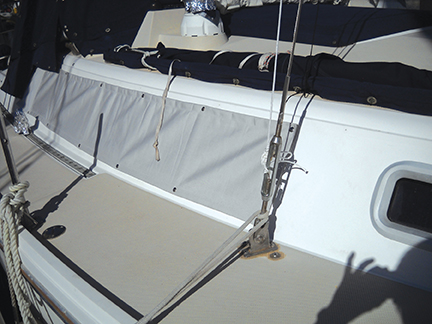
PREPARING THE INTERIOR
Rules like ‘remove all food’ are just basic common sense. Some folks leave cans on board but they bundle them into plastic bags and stow them in safe places in case one or more explode. All other food must be removed so as to prevent it becoming yummy enticement for those creepy crawly critters. Protect your teak. A good wipe down with vinegar and water will go a long way to protecting your teak from mold and mildew. Many cruisers make this a monthly habit throughout the season as well. Secure your electronics. Some of the joys of a Mexican summer are the numerous thunder and lightning storms. Many folks will assure you lightning only strikes the taller masts. Some skippers of small boats will disagree, having been struck while surrounded by much larger craft. We choose to be safe and disconnect all our electronic equipment. We also stow some of the more expensive pieces in the oven (emulating a kind of Faraday Shield). Clothing, linen, books and papers can be protected from the inevitable dust and/or moisture by bagging (space bags work very well and save room too). Upholstery will benefit from a good vacuuming and being stood on end with a dust cover as protection.
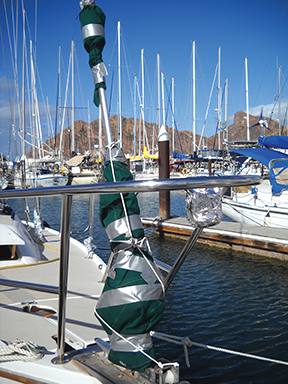
Covering the windows is also a good idea, with one caveat. Lining the inside of acrylic or plexi-glass windows and hatches will likely result in crazed panes. The foil will actually intensify the heat from the sun’s rays. Instead, these materials should be covered on the outside. Windows that open need to be leak proof… remember those torrential rains? Water tanks need attention too. Some folks leave them empty, some leave them full. We leave them mostly full having poured a bottle of bleach into each. We also leave one inspection port open to allow for some evaporation during the very dry periods. Propane lines should be run dry and tanks stored where they can’t leak into the boat. Aerosol cans should be removed completely due to their propensity to explode in extreme heat. Batteries should be removed from all flashlights and other battery-dependent equipment. Cupboard doors, locker lids, and cabin doors should be propped open to allow air movement. All access points to the interior should be plugged or set up with netting to prevent unwanted visitors from the outdoors. There may be two sets of openings connected to your dorade vents and both should be dealt with. Plastic scrubbies (the kind we use for cleaning dishes) make great plugs for openings. They allow air and water to pass through at the same time as they keep most bugs out. And, finally, before locking up those companionway boards, critter proofing must be considered. Good roach bait, set up in all the hard to get at corners (and according to the instructions) is a good start. Boric acid, mixed into a paste with water, works well for cockroaches. Setting short pieces of hose along the edges of lockers, etc. is a good way to dispense it and keep your pets safe at the same time. Lastly, do not forget to close all through-hulls. Now that the inside seems well cared for, let’s take a step outside.
PREPARING THE EXTERIOR
Securing the outside of our boat is equally important. Much of this work is easier to do while the boat is in the water, enjoying cooler sea breezes. The heat of a dusty, dry boat yard can be stifling and very difficult to work in. Removing sails is a great way to start. Cleaned, if necessary, and nicely folded… the sails can be stowed on one of the bunks below. Running rigging needs attention as well. If your lines need to be cleaned they should come right off. This is best accomplished using messenger lines (one for each) which will allow a relatively easy re-running of the lines at the start of the next season. Don’t forget to label the lines themselves and the messenger lines. We label with tape and then cover the messenger line labels with tin foil to protect them over the summer. All messenger lines should be secured to a location that will prevent them from banging on the mast or tangling with other lines. Chafe is your worst enemy as lines chafed through will have to be retrieved by climbing the mast… a job to be avoided whenever possible.
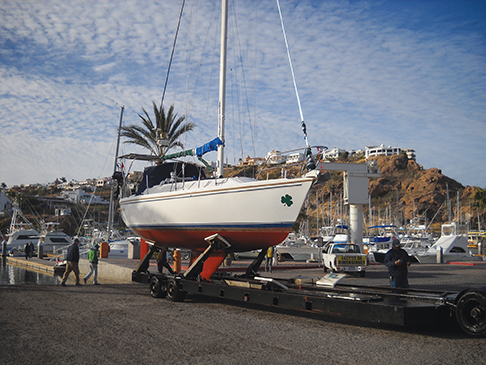
If your running rigging is newer and/or not in need of a good cleaning, you may (using a messenger line) run it up and into the mast. That will protect some of the line and you can then bundle up the remainder and cover it for protection (a great job for an old sail bag). We also take the time to do a few diagrams of some of the more complicated running rigging (like the boom vang, mainsheet, and lazy-jacks). Just a precaution, but very handy come six months later when your memory has understandably faded. Rigging and sails taken care of our focus moves to deck hardware. UV can do considerable damage to vulnerable pieces of nylon and material left exposed. Wrapping with good quality tin foil can provide great protection from both UV rays and wind-blown dust and grit. It will also save you hours of cleaning at the start of the next season. Covered properly, your equipment should be in the same condition when you return.
Speaking of covering; old sail material and old Sunbrella make great covers for things like roller furling, booms, lines remaining outside the mast, solar panels, outboards, and permanently installed BBQs. A product called Tyvek (house wrap), sold by Home Depot in Canada and the U.S., is also very good and well worth the trouble of carrying down. Some folks cover their solar panels and some folks don’t (relying on their solar panel monitor to work properly while they are gone). We choose to cover ours partially, leaving a small portion to operate much like a trickle charger.
More than one boat has been severely damaged due to internal flooding caused by water ingress through broken windows, damaged mast boots, and even being set up improperly on storage stands. The boat should be set on the support stands with the appropriate slope to allow the cockpit to drain freely. The bilge pump should remain powered and available to clear any water that does find its way in and collects in the bilge. Small mud wasps are becoming more prevalent and just love to nest in whatever openings they can find. Beware the open spaces offered by your anchor locker lid, your open ended boom, the thru-hull openings, and holes in your barge boards (set up to secure your fuel and water jugs). Those small spaces are very attractive to small critters and need to be covered or filled with scrubbies. Lifelines and canvas need to be removed. Taking them off is not difficult and stowing them below keeps them clean. The dodger, bimini and spray cloths if you have them should also be removed. Cleaning them (hosing off the salt and dust) and letting them dry before stowing will make them easier to fold and save time in the fall as well.
Some people fold the dodger framework flat, and others don’t. That’s a personal choice based on how you choose to cover the deck. Many cruisers don’t cover their deck at all, leaving as low a profile as possible. Others choose to cover what they can with shade cloth. We have tried both and, while securing the tarps takes a little more time, we believe the shade cloths do help keep the temperatures inside somewhat cooler. If you decide to use the shade cloths, or tarps of any kind, they must be secured well to prevent being shredded by the summer winds.
MECHANICS AND EQUIPMENT
Whatever you need to do to protect your engine, outboard and any other equipment with ‘needs’ must be done. If there is ever a time to ignore maintenance… this is not it. Engines need at least an oil change, fresh water flush .and the loosening and/or removal of rubber bits like impellers and V belts. Other equipment may require some protective coating or packaging to protect it from moisture. Watermakers will need to be pickled for the season. Corroded electrical connections are a common cause of difficulties with VHF radio transmissions and other such things, and should be cleaned and treated as required.
And finally, while it’s tempting to do without… adequate insurance (including Mexican liability insurance) is important. Accidents do happen; if not to your boat then to the boat next door; and sometimes, sadly, one vessel’s problems can rapidly spread to the next.
So my sailing friends…take heart. Believe me when I tell you it does get easier. Each year you’ll find ways to streamline the process, and… just like the grey winter days we seek to avoid by sailing in Mexico, it only takes one day of sunshine with your sails nicely set to forget about the dusty hot sweat. ‘Tis a small price to pay for sailing in Paradise.
An adventurer by nature, Carolyn grew up sailing in the southern coastal waters of BC. In 2011 she and her partner sailed their Ontario 32 Shannon from Victoria to Mexico and she now spends her winters exploring the Sea of Cortez aboard Shannon’s Spirit (a Catalina 34). An active member of the Bluewater Cruising Association, Carolyn has written numerous articles about sailing and the life-changing experience of her trip down the coast of North America.














